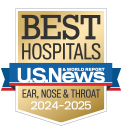Nasal Surgery (Rhinoplasty)
Nasal surgery can correct functional breathing problems (septoplasty) and the aesthetic appearance of the nose (rhinoplasty). Reshaping the nose requires careful attention to facial balance and proportion, resulting in a nose that looks natural and in proportional balance with other facial features. Creating this balance is an art and can significantly enhance facial appearance. Rhinoplasty is often performed under local anesthesia with minimal time off from work.
The Surgery
First, incisions are made and the bone and cartilage support system of the nose is accessed. The majority of incisions are made inside the nose, where they are invisible. In some cases, an incision is made in the area of skin separating the nostrils. Next, certain amounts of underlying bone and cartilage are removed, added to, or rearranged to provide a newly shaped structure. For example, when the tip of the nose is too large, the cartilage area is sculpted to reduce size. The angle of the nose in relation to the upper lip can be altered for a more youthful look or to correct a distortion.
The tissues are then redraped over the new frame and the incisions are closed. A splint is applied to the outside of the nose to help retain shape while the nose heals. Soft, absorbent material may be used inside the nose to maintain stability along the dividing wall of the air passage called the septum. Alternatively, soft nasal support that permit nasal breathing post-operatively can be placed. Risk factors in rhinoplasty are generally minor.
Post Surgery
Immediately after surgery, a small splint will be placed on your nose to protect it and to keep the structure stable for at least five to eight days. If packing is placed inside the nose during surgery, it is removed the morning following the surgery. Your face will feel puffy, especially the first day after surgery. Pain medication may be required. You are advised to avoid blowing your nose for seven days after surgery. In the immediate days following surgery, you may experience bruising and minor swelling in the eye area. Cold compresses often reduce the bruising and discomfort. Absorbable sutures are usually used that do not have to be removed. Nasal dressing and splints are usually removed six or seven days after surgery.
It is crucial to keep your head elevated after surgery. Some activities will be prohibited in the weeks after the procedure. Sun exposure, exertion, and risk of injury must be avoided. If you wear glasses, special arrangements must be made to ensure that the glasses do not rest on the bridge of the nose. Tape and other devices are sometimes used to permit wearing glasses without stressing the area where surgery was performed.
Follow-up care is vital for this procedure to monitor healing. Anything unusual should be reported immediately. It is essential that you keep your follow-up appointments.
Insurance does not generally cover surgery that is purely for cosmetic reasons.


